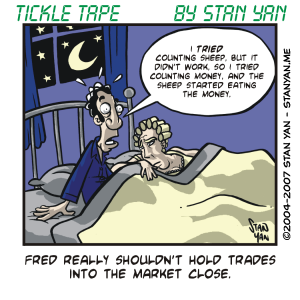If you’re like most people, your moods change throughout the day. There are times when you are extremely energetic and optimistic. You feel like you can do anything. You are in an optimal state of mind for trading. A state of mind consists of a constellation of moods, feelings, thoughts, and memories. In an optimistic state of mind, you feel powerful and ready for action; you feel enthusiastic and energized.
You have a can-do attitude. You remember past triumphs and you’re inspired as you think of your past accomplishments. You are open to new ideas, and you can creatively think of new trading strategies. You can’t wait to trade. At other times, though, you may feel down in the dumps and beaten, as if you are paralyzed by your emotions. You remember every failure, no matter how small, and you wrongly believe that these minor setbacks illustrate your inadequacy. As you might imagine, some states of mind are more conducive to trading than others.
Sometimes our moods, and corresponding states of mind, change for no apparent reason; it may just be the time of day or a biological mechanism. Other times, our moods reflect daily events, such as a string of unexpected losing trades. But regardless of how it happens, our current state of mind impacts how we approach trading.
When you are ready to execute a trade based on your meticulously defined trading plan, and you are also in an optimistic state of mind, you execute your plan flawlessly. Other times, in contrast, our states of mind are less than optimal. For instance, we may feel pessimistic when we are ready to execute a viable trading plan, and if we allow these feelings to dictate our actions, we may decide to abandon the plan for no good reason.
It would be nice if we were always in an optimal state of mind, but it isn’t always the case. Some traders are naturally tired during the trading day, but in the evenings, after a little rest, they think clearly and creatively. These traders may find it useful to devise specific trading plans off-hours when they are in a creative, optimistic mindset. When they go to execute the plan the next day, though, they may feel dreary and unenthusiastic.
If they have a well-defined plan that is clear and easy to follow, however, they find they can ignore their current feelings, and focus all their energy on executing the plan. They may think, “I’m not going to let my low energy mood interfere. I can’t think clearly when I’m like this, so I’m going to just focus on execution and live with what happens. As long as I follow my plan, I will have met my objective.”
Other traders may be overly optimistic during the trading day. Extreme optimism can be dangerous. Overly optimistic traders may feel invincible and get a swelled head. They may impulsively put on low probability trades, seeing positive signs when there aren’t any. Later in the day, they may think, “How could I have been so impulsive?” During more calm and rational moments, they may see things more clearly. At these times, they would be wise to use these states of mind to clearly map out trading plans. Once the trades are mapped out and clearly specified, the trading plans can be more easily executed when market conditions are just right.
Because our moods may not be optimal at the moment of execution, a detailed trading plan can ensure that a trade is executed with discipline. Whether you are overly optimistic, dreary and pessimistic, fearful and anxious, or frustrated and scattered, if you have a well-defined trading plan, you can temporarily ignore your current state of mind, and focus all your available energy on executing the plan. A less than optimal state of mind doesn’t have to hamper your trading. You can still trade profitably if you make a detailed plan and trade it.


